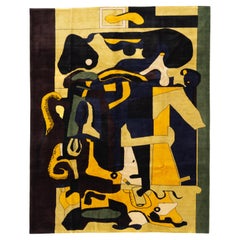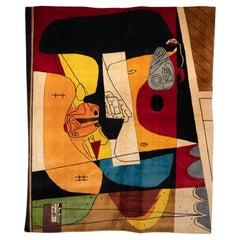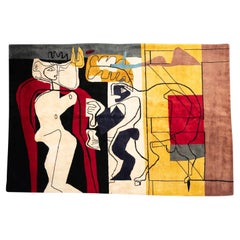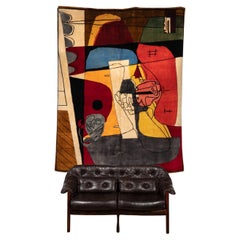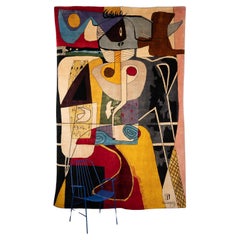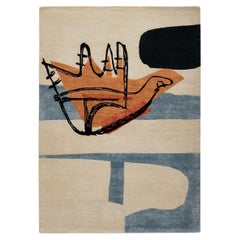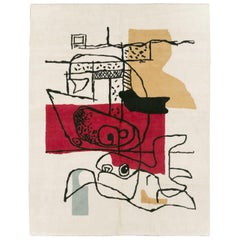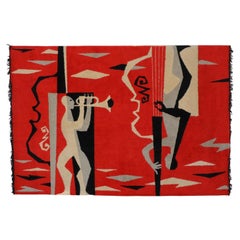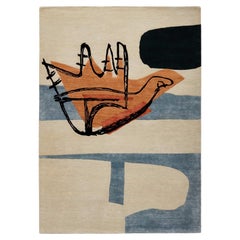Le Corbusier Rug
21st Century and Contemporary French Western European Rugs
Wool
Late 20th Century Tapestries
Wool
Late 20th Century Tapestries
Wool
Mid-20th Century Tapestries
Wool
Vintage 1950s Unknown Tapestries
Wool
2010s Italian Caucasian Rugs
Fabric, Wool
21st Century and Contemporary Turkish Modern Turkish Rugs
Wool
Mid-20th Century Belgian Mid-Century Modern Western European Rugs
Yarn
2010s Italian Mid-Century Modern Tapestries
Wool
2010s Spanish Modern Indian Rugs
Wool
Late 20th Century Turkish Aesthetic Movement Turkish Rugs
Wool
21st Century and Contemporary Pakistani Brutalist Moroccan and North Afr...
Wool
21st Century and Contemporary Moroccan Minimalist Moroccan and North Afr...
Wool
21st Century and Contemporary Pakistani Brutalist Moroccan and North Afr...
Wool
21st Century and Contemporary Moroccan Minimalist Moroccan and North Afr...
Wool
1960s Realist Interior Prints
Lithograph
21st Century and Contemporary Pakistani Minimalist Moroccan and North Af...
Wool
Vintage 1950s Czech Mid-Century Modern Western European Rugs
Wool
21st Century and Contemporary Moroccan Post-Modern Moroccan and North Af...
Wool
21st Century and Contemporary Pakistani Modern Western European Rugs
Wool
20th Century Portuguese Western European Rugs
Wool
21st Century and Contemporary Pakistani Brutalist Moroccan and North Afr...
Wool
21st Century and Contemporary Indian Mid-Century Modern Moroccan and Nor...
Wool
21st Century and Contemporary Pakistani Minimalist Moroccan and North Af...
Wool
21st Century and Contemporary Moroccan Minimalist Moroccan and North Afr...
Wool
Vintage 1950s Moroccan Moroccan and North African Rugs
Wool
Vintage 1960s French Mid-Century Modern Western European Rugs
Wool
21st Century and Contemporary Pakistani Brutalist Moroccan and North Afr...
Wool
21st Century and Contemporary Pakistani Brutalist Moroccan and North Afr...
Wool
21st Century and Contemporary Moroccan Bauhaus Moroccan and North Africa...
Wool
21st Century and Contemporary Moroccan Mid-Century Modern Moroccan and N...
Wool
1960s Realist Interior Prints
Lithograph
1960s Realist Interior Prints
Lithograph
20th Century Chaise Longues
Leather
Le Corbusier Rug For Sale on 1stDibs
How Much is a Le Corbusier Rug?
Finding the Right Rugs-carpets for You
Good antique rugs and vintage rugs have made their way into homes across the globe, becoming fixtures used for comfort, prayer and self-expression, so choosing the right area rug is officially a universal endeavor.
In modern usage, “carpet” typically denotes a wall-to-wall floor cushioning that is fixed to the floor. Rugs, on the other hand, are designed to cover a specific area and can easily be moved to new locations. However, the terms are interchangeable in many parts of the world, and, in the end, it won’t matter what you decide to call it.
It’s well known that a timeless Persian rug or vintage Turkish rug can warm any interior, but there are lots of other styles of antique rugs to choose from when you're endeavoring to introduce fresh colors and textures to a bedroom or living room.
Moroccan Berber rugs are not all about pattern. In fact, some of the most striking examples are nearly monochrome. But what these rugs lack in complexity, they make up for in brilliant color and subtle variation. Moroccan-style interiors can be mesmerizing — a sitting room of this type might feature a Moroccan rug, carved wooden screens and a tapestry hung behind the sofa.
Handwoven kilim rugs, known for their wealth of rich colors and unique weaving tradition, are pileless: Whereas the Beni Ourain rugs of Morocco can be described as dense with a thick surface or pile, an authentic kilim rug is thin and flat. (The term “kilim” is Turkish in origin, but this type of textile artistry is practiced all across the Balkans, throughout the Arab world and elsewhere.)
When it comes to eye-catching floor coverings, the distinctive “medallion” pattern of Oushak rugs has two types of rounded shapes alternating against a rich red or blue background created with natural dyes, while the elaborate “star” pattern involves large eight-pointed shapes in diagonal rows alternating with diamonds.
If you’re looking for something unexpected, find a runner rug that pops in your hallway or on your stairs. Dig for dazzling geometric patterns in our inventory of mid-century modern rugs and carpets, which includes works designed by the likes of Swedish textile masters Märta Måås-Fjetterström, Marianne Richter and other artisans.
Carpets and rugs have been around for thousands of years. Prehistoric humans turned to animal skin, wool and fur to craft simple fabrics to soften hard terrain. A 2016 study suggests that "cave lions" were hunted for exactly this purpose, and that decorating your cave with their pelts may have conferred strength and prestige. Although many of these early textiles are still in existence, tracing their precise origins is difficult. Carpets quickly became such a valuable trade commodity that the weavings could easily travel far from their places of origin.
The oldest known carpet was found in southern Siberia. (It may have traveled there from Persepolis in Iran.) For the flat-weave floor rugs crafted by Native Americans, cotton was the primary material before sheep’s wool was introduced in the 16th century. In Europe, carpet-making was fundamental to folk art, and Asian carpets imported to European countries were at one time considered a precious luxury and not intended to remain permanently on the floor.
With the variety of area rugs and carpets rolled out for you on 1stDibs — a collection that includes traditional, modern, minimalist rugs and other coverings of all kinds — things will be looking up whenever you’re looking down.
- What is Le Corbusier famous for?2 Answers1stDibs ExpertFebruary 22, 2021Le Corbusier was an architect, furniture designer and city planner who is famous for designs that combined bold expression and function. He promoted open, efficient spaces and clean geometric forms. Find furniture designed by Le Corbusier and his collaborators on 1stDibs.1stDibs ExpertApril 5, 2022The Swiss-born Charles-Édouard Jeanneret, best known by his adopted name Le Corbusier, is famous for his work as an architect, city planner and designer who combined bold sculptural expressionism with functionality. Often referred to as the pioneer of progress-minded architecture, Le Corbusier is widely influential. His career spanned almost five decades, and his furniture is known to be refined and chic. Shop a selection of Le Corbusier furniture on 1stDibs.
- What did Le Corbusier invent?1 Answer1stDibs ExpertApril 5, 2022Le Corbusier invented a style of design called brutalism, which is characterized by unornamented, sleek and smooth furniture and architecture. The design style emphasizes hand-crafted, natural elements and rejects modern materials and technology. Shop a range of Le Corbusier furniture on 1stDibs.
- Why is he called Le Corbusier?1 Answer1stDibs ExpertAugust 15, 2024The Swiss architect and designer is called Le Corbusier because he chose the name for himself. Born Charles-Édouard Jeanneret, Le Corbusier derived his pseudonym from the surname Lecorbésier, which belonged to some of his family members. A pioneer of progress-minded modern architecture, Le Corbusier sought to impose a rational order on the chaos of the world through design. He rejected excessive architectural ornament and created buildings with elemental geometric forms. Le Corbusier’s furniture espouses these same ideals. His designs are spare, minimal and efficient, but at the same time offer supreme comfort. Find a wide range of Le Corbusier furniture on 1stDibs.
- What was Le Corbusier’s style?1 Answer1stDibs ExpertApril 5, 2022Le Corbusier’s style of design is known as brutalism and his furniture designs are minimalist and efficient. Many of his furniture pieces combine industrial design with comfort and warmth. Shop a selection of Le Corbusier furniture from some of the world’s top dealers on 1stDibs.
- What was Le Corbusier’s theory?1 Answer1stDibs ExpertAugust 8, 2024Le Corbusier's theory is known as the five points of architecture. Developed in the 1920s, these principles had a major influence on the approach to modern architecture and include pilotis (elevating a building on pylons), the free design of a façade, the free design of a ground plan, a horizontal window and a roof garden. The architect prioritized modern, open interiors and emphasized light, rational designs. His architecture and interiors share a clear sense of space and structural order, underscoring beauty in harmony, proportion and simplicity. He rejected excessive architectural ornament and created buildings with elemental geometric forms that were made of industrial materials such as steel and reinforced concrete. Le Corbusier’s furniture espoused these same ideals. His designs are spare, minimal and efficient, but at the same time, they offer supreme comfort. On 1stDibs, explore a selection of Le Corbusier furniture.
- 1stDibs ExpertApril 5, 2024Le Corbusier's architectural style was modernism. Specifically, he helped to shape the International Style, which emphasized simple, rectilinear forms and open interior spaces. A fine example of this approach can be seen in Le Corbusier's Villa Savoye in Paris. Not just an architect, Le Corbusier also worked as a designer, and his furniture is largely associated with the mid-century modern design movement. Find a selection of Le Corbusier furniture on 1stDibs.
- 1stDibs ExpertApril 5, 2022Le Corbusier furniture is part of the modernist movement, with simple and sleek designs at the forefront of all furniture pieces. Shop a collection of Le Corbusier furniture from some of the world’s top sellers on 1stDibs.
- 1stDibs ExpertSeptember 27, 2024Charles-Édouard Jeanneret was called Le Corbusier because that was the name the French-Swiss designer and architect chose for himself. His maternal grandfather's name was Lecorbésier, and Jeanneret altered the surname to create his adopted name. Le Corbusier was a pioneer of progress-minded modern architecture who sought to impose rational order on the chaos of the world through design. On 1stDibs, shop a diverse assortment of Le Corbusier furniture.
- 1stDibs ExpertOctober 7, 2024The main difference between Frank Lloyd Wright and Le Corbusier is the architects’ philosophy. Frank Lloyd Wright helped pioneer organic architecture—buildings that coexist harmoniously with their natural surroundings. As a result, he often preferred to use natural and even local materials in his buildings and furniture. Le Corbusier was more progress-minded and sought to impose rational order on the world's chaos through design. He focused on designs for living in modern urban settings. In his furniture, he tended to blend natural and human-made materials, such as tubular chrome and genuine leather. On 1stDibs, shop a variety of Frank Lloyd Wright and Le Corbusier furniture.
Read More
Hechizoo’s Original Sin Rug Tempts with Shimmering Copper, Tin and Bronze
Embroidered with snakes, turtles, birds and vines, it celebrates a dazzling natural world before the arrival of Adam and Eve.
Splashy Blooms Bud and Wilt in Artist Santi Moix’s Floral Rug
The colorful design captures the natural splendor of a backyard garden.
In South Africa, Rich Mnisi Is Taking Biomorphic Design to the Next Level
The rising fashion star is having his first solo show of furniture designs, at Southern Guild in Cape Town, and his far-out, snaking forms are like nothing you've ever seen.
The Artists and Designers behind Today’s Coolest Rug Collaborations
Top carpet companies are expanding the arena of artful floor coverings, seeking out creatives from other media and marrying their talents to textiles.
Tantuvi’s New Rugs Were Inspired by the Travertine Quarries of India and the Spanish Steps of Rome
The New York–based rug designers employ earthy colors and time-honored artistry in their creations.
We’re Going Gaga for the New Sasha Bikoff Rugs
The New York interior designer found inspiration in disco culture and astrology for her debut home collection.
Paradise Is Found Underfoot in These Majestic Persian Textiles
Persian garden carpets, with their timeless beauty and unmatched craftsmanship, have an enduring appeal.
12 Mesmerizing Moroccan-Style Interiors
With their rich layers, intricate patterns and elaborate lighting, rooms with a Moroccan influence are easy to spot.
